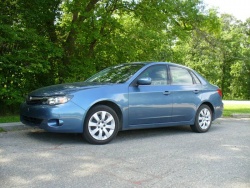 2010 Subaru Impreza 2.5i sedan. Click image to enlarge |
|
Related articles on Autos
Manufacturer’s web site
|
Review and photos by Haney Louka
Photo Gallery:
2010 Subaru Impreza
Subaru’s entry-level model was redesigned for the 2008 model year and soldiers on essentially unchanged. Even so, I was looking forward to taking this one for a week-long spin. The reason for my enthusiasm was that Subaru bravely decided to send through a bare-bones four-door sedan with a manual transmission and exactly zero options. Sending us a base model helps us focus on a particular model’s intrinsic properties without being distracted by more powerful engines or fancy sound systems. And sadly, press cars with manual transmissions are becoming a rare sight in our nation’s press fleets.
So here it is, the $20,995 Subaru Impreza 2.5i. You could shell out another $1,100 for the four-speed slushbox, but that would be like placing a sushi order with only cooked ingredients: what’s the point?
The Impreza is one of those rare cars that has actually become less expensive over the years: going back into my road test archives, I found that the 2002 Impreza TS started at $21,995.
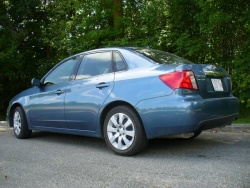 2010 Subaru Impreza 2.5i sedan. Click image to enlarge |
So even though the Impreza once commanded a hefty premium compared with its competitors, the current model is priced much more aggressively when measured against its peers. Chief among the features that make up the Impreza’s value proposition is the presence of standard all-wheel drive; a feature that can’t be had on its more mainstream competitors like the Mazda3 and Volkswagen Jetta. While there are several other cars in this highly competitive class, I name those two as prime competition because of the higher take rate of manual transmissions compared with others in this class.
The Japanese automaker makes much of the Impreza’s rally-bred all-wheel drive system, which splits power evenly between front and rear axles until decreased traction dictates otherwise, at which time the viscous limited-slip centre differential directs power to the wheels with more grip.
Other standard features on the Subie include four-wheel disc brakes, fully independent suspension, air conditioning, steering-wheel mounted cruise control, two power outlets, power windows with driver’s auto down, remote keyless entry, dual mufflers, a strut-supported hood, 16-inch steel wheels with plastic covers, a trip computer, side curtain airbags, and electronic stability control.
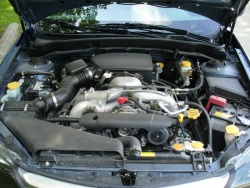 2010 Subaru Impreza 2.5i sedan. Click image to enlarge |
For 2011, the Impreza line gains larger rear-seat head restraints and new option packages that incorporate Bluetooth hands-free connectivity and higher-end sound systems.
As is expected from Subaru, under the Impreza’s hood is a horizontally-opposed four-cylinder “boxer” engine that displaces 2.5 litres. This flat configuration has long been one of Subaru’s trademarks (their six-cylinder models also share this horizontally-opposed piston arrangement) and continues to help define the character of the car. Subaru asserts that their boxer engine sits lower in the engine compartment, contributing to an overall lower centre of gravity for the car. For me, the primary benefits are its torquey nature and the unique growl of the flat-four under acceleration. Power output for the mill is rated at 170 hp and 170 lb-ft of torque: figures that are more in common with optional engines from the Impreza’s competitors.
Driving the Impreza has become a bit less exciting with this latest generation. In the quest to go more mainstream, the car has lost some of the sparkle of past models. In particular, the suspension tuning feels too soft for what used to be a sporty car and the resultant isolation from the road gives it a somewhat appliance-like demeanour. I also found the shifter to be more rubbery than I like, further detracting from the day-to-day driving joy that a well-sorted compact car can provide. There’s no question that this chassis can support (and Subaru’s engineers are capable of delivering) a significantly higher level of handling and driver involvement: one drive in a WRX makes that abundantly clear.
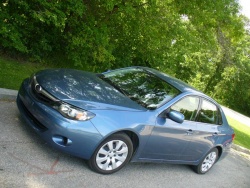 2010 Subaru Impreza 2.5i sedan. Click image to enlarge |
I still do find the boxer engine’s broad torque curve quite satisfying, and there’s a commendable level of feedback from the car’s steering that keeps the Impreza a step ahead of the true class appliance, the Toyota Corolla. But what disappoints me is that other manufacturers can infuse the fun of higher-powered cars into their base trim levels (as with the Jetta and Mazda3) and I was hoping that would be the case here.
As well, the Impreza is styled so as not to offend the masses, to the point of almost complete anonymity, with the words “generic Japanese sedan” being the most apt descriptors. Again, Subaru designers’ capabilities are reserved for more expensive versions of the car: the WRX has exterior upgrades that at once add a sporty and aggressive stance to the same basic car. A hood scoop, fog lights, fancy wheels, and a spoiler: I never thought I would fall for such gratuitous styling cues (okay, so the hood scoop is functional), but I must say they do make a difference here.
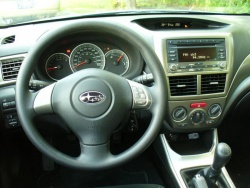 2010 Subaru Impreza 2.5i sedan. Click image to enlarge |
Thankfully, the view from the driver’s seat does possess the same sportiness as higher-performing members of the Impreza line-up. A three-spoke wheel (which tilts but doesn’t telescope) with buttons for the cruise control sits just in front of a straightforward instrument panel that has gauges for road speed, engine speed, and fuel level. The expected coolant temperature gauge has been replaced by blue and red lights for extremes. No light, no problem.
A display at the top of the centre stack shows current temperature, clock, and trip computer information and falls easily to view for a quick glance. The head unit for the four-speaker audio system sits just below, while less-frequently adjusted dash vents and HVAC controls occupy their rightful place further down toward the centre console.
The four-speaker stereo can play MP3 discs as well as audio from an auxiliary source via a centre console-mounted jack. Sound quality is strictly average for this class, with more powerful units available on higher trim levels.
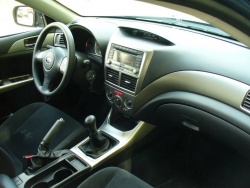 2010 Subaru Impreza 2.5i sedan. Click image to enlarge |
Seat fabric is of the black velour variety that manages to hang on to lint and fluffs with tenacity, making it a bit of a challenge to keep looking clean. The seats are comfortable, however, and the rear bench splits 60/40 to add to the Impreza’s smallish 320-litre trunk (Jetta gets 487 litres while the Mazda has 335).
Subaru has managed to build an entry-level model that will appeal to a broad spectrum of buyers, particularly those who place all-wheel drive high on their wish lists. But its generic styling inside and out, combined with its laid-back attitude on the road, make it a less appealing entry if you’re looking for some excitement in your ride.
|
Pricing: 2010 Subaru Impreza 2.5i sedan
Click here for options, dealer invoice prices and factory incentives
Specifications
Competitors
Crash test results
|







 Follow Autos on Twitter
Follow Autos on Twitter



